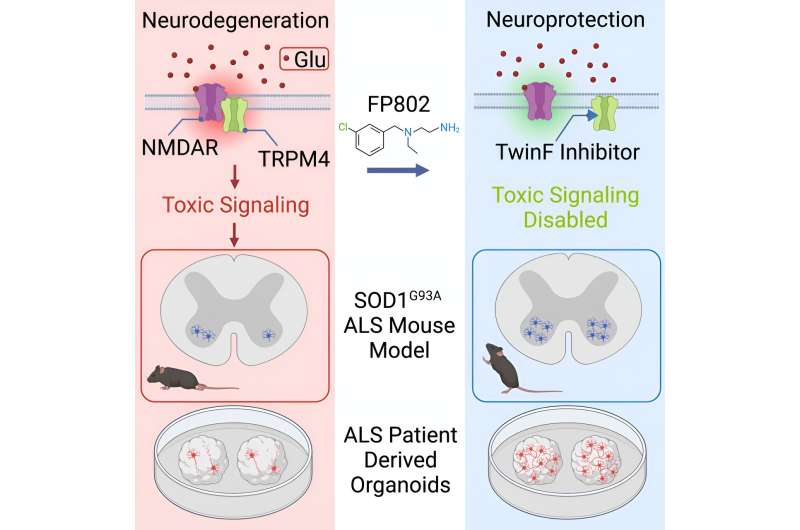This article has been reviewed according to Science X's editorial process and policies. Editors have highlighted the following attributes while ensuring the content's credibility:
fact-checked
trusted source
proofread
Neurobiologists successfully test novel drug principle in a mouse model and in brain organoids of ALS patients

A research team led by Prof. Dr. Hilmar Bading, neurobiologist at Heidelberg University, examined a neuroprotective molecule that belongs to a novel drug class. It is able to inhibit the interactions of certain proteins and has been successfully tested in a mouse model of amyotrophic lateral sclerosis (ALS) and in brain organoids of ALS patients.
The findings are published in the journal Cell Reports Medicine.
"On the long road to an effective treatment for ALS patients, these findings from basic research may represent a significant step forward," says Prof. Bading.
ALS is a degenerative disease of the nervous system particularly affecting and harmful to motor neurons. As the disease progresses, the nerve cells controlling voluntary muscle movement die. That leads to a progressive wasting of the muscles responsible for moving and speaking, but also for eating and breathing. To date, says Prof. Bading, there is no effective drug treatment for ALS patients, who in most cases die within two to five years after the diagnosis.
The FP802 molecule the Heidelberg scientists used in the study belongs to a new pharmacological class of drugs. These are TwinF interface inhibitors, which were discovered by Prof. Bading and his team at the Interdisciplinary Center for Neurosciences (IZN) of Heidelberg University. These inhibitors disrupt the physical interactions of two ion channel proteins, with the names NMDA receptor and TRPM4, which, due to a so-called protein pocket named TwinF by the Heidelberg scientists, form a protein-protein complex.
NMDA receptors are found on the cell surface of nerve cells and are present both in the synapses, the contact points between the nerve cells, and outside these contact points. They are activated by a biochemical messenger substance, the neurotransmitter glutamate. The stimulation of synaptic NMDA receptors in the brain contributes to learning and memory processes, as well as to protecting nerve cells.
Outside the synapses, however, the activation of these receptors leads to the damaging of nerve cells and to their death. The team led by Hilmar Bading investigated the reasons for this in a prior study. They found out that TRPM4 confers toxic properties to the extrasynaptic NMDA receptors in the brain. Together these two proteins form a "death complex," which also plays a role in ALS.
The neuroprotective molecule FP802 binds to the TwinF protein pocket of TRPM4, blocks the contact areas of the interacting proteins, and thereby disrupts the fatal complex of NMDA receptors and TRPM4. The Heidelberg scientists have studied this new drug principle using an ALS mouse model as well as brain organoids of ALS patients.
"With this completely new therapeutic concept in combating neurodegenerative diseases we were able to achieve remarkable outcomes," says Prof. Bading.
The scientist explains that it was possible to prevent cell death and hence the loss of spinal motor neurons of mice by giving them the neuroprotectant. This treatment improved their motor abilities, mitigated the progression of the disease and extended the lifespan of the animals.
"The discovery of this new pharmacological class of drugs opens up a promising path for fighting ALS. A long-term goal is to develop TwinF interface inhibitors for use in patients," says Hilmar Bading.
In close cooperation with the startup FundaMental Pharma, a Biotech offshoot of the IZN Department of Neurobiology, the molecule FP802 is to be optimized for use in humans in the coming years and tested for efficacy in clinical trials. Dr. Jing Yan, who was involved in the latest study, recently joined FundaMental Pharma in order to accelerate the further development of FP802.
More information: Jing Yan et al, TwinF interface inhibitor FP802 stops loss of motor neurons and mitigates disease progression in a mouse model of ALS, Cell Reports Medicine (2024). DOI: 10.1016/j.xcrm.2024.101413





















